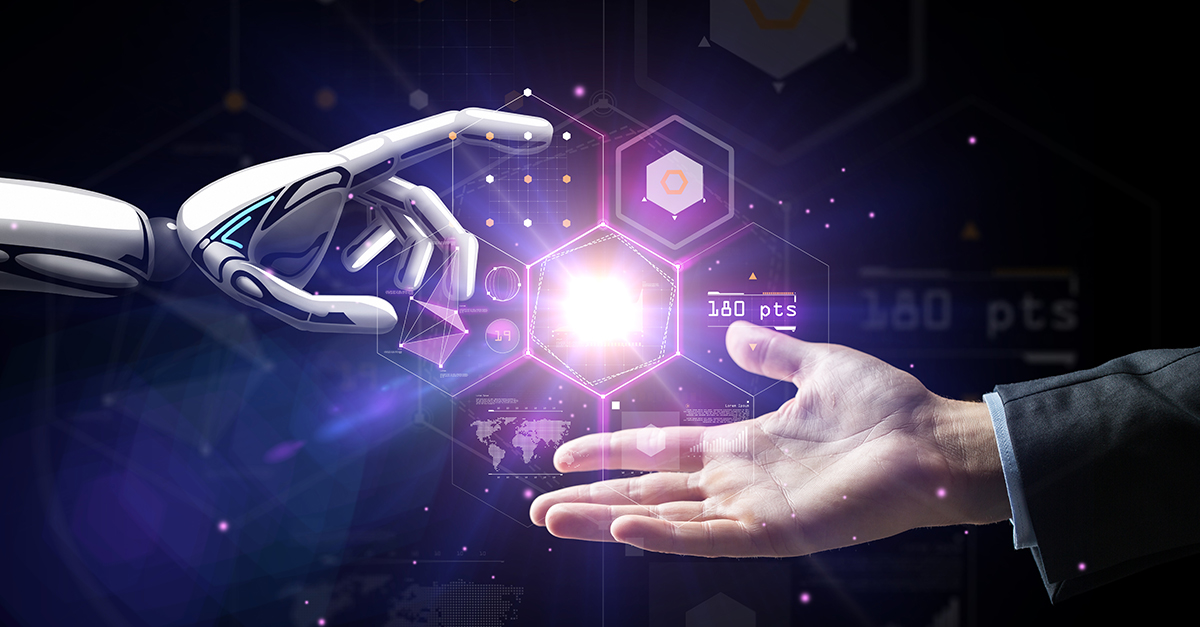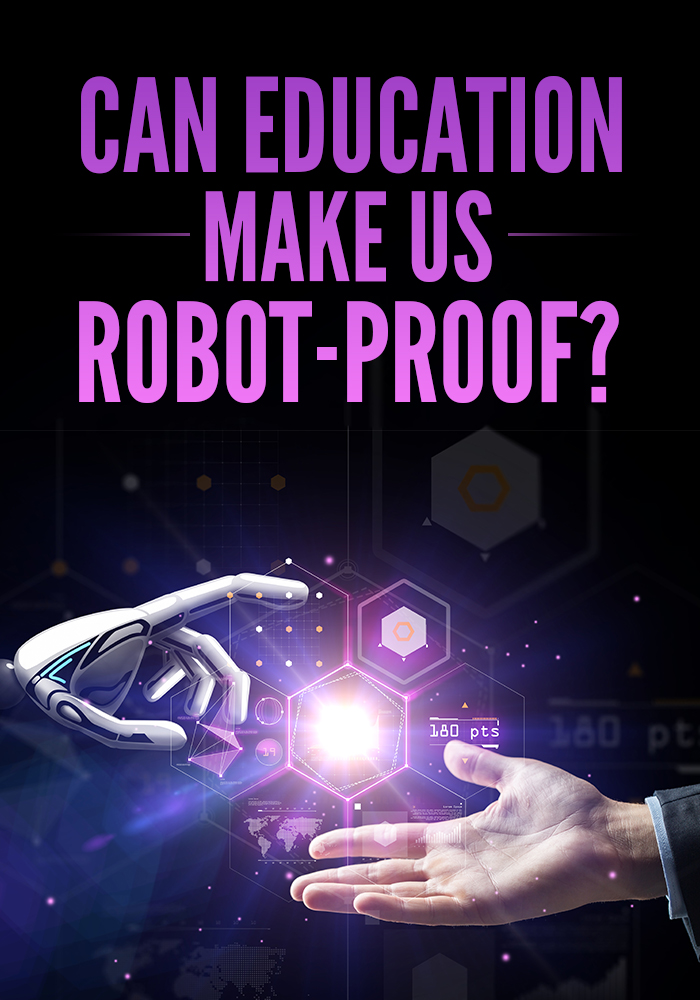Can Education Make Us Robot-Proof?

Joseph E. Aoun has been president of Northeastern University for twelve years. During his tenure, he has thought deeply about the role of education.
In his recent book, Robot-Proof: Higher Education in The Age of Intelligence, Aoun asks “How should education be used to help people in the professional and economic spheres?” He notes that “as a university president, this is no small question for me…the university I lead, Northeastern, is explicitly concerned with the connections between education and work.”
Like many of our nation’s thinkers, Aoun is deeply concerned with how automation, artificial intelligence, and robotics will transform economies and displace workers. Thankfully, Aoun’s own rich academic background in linguistics and philosophy as well as his experience as a leader in higher-education have combined to give him a vision for robot-proof education. The education that Aoun recommends is a blend of the liberal arts and STEM, a mix of textbook and experiential learning, a balancing of the contemplative and practical.
Education is its own reward, equipping us with the mental furniture to live a rich, considered existence. However, for most people in an advanced society and economy such as ours, it also is a prerequisite for white-collar employment.
Aoun thinks there are two kinds of thinking that are uniquely human and that need to be emphasized in education. The first is critical thinking – something often talked about but not always well defined or understood. He defines critical thinking as “analyzing ideas in a skillful way and then applying them in a useful one.” Moreover, “to do this well, a person needs to be able to observe, reflect, synthesize, and imagine concepts and information and to communicate the results of the process.” Critical thinking goes hand-in-hand with the second model of thinking, systems thinking. This approach “involves seeing across areas that machines might be able to comprehend individually but that they cannot analyze in an integrated way, as a whole.” For example, even a well-coded algorithm can’t tell us “why certain hashtags on Twitter are trending, why the global commodities markets are rising and falling, why the Antarctic ice shelf is melting.” Aoun gives a concrete example of how humans and computers can work together: “…in the case of wind blow-over derailment, computers can help a team of engineers predict when it is likely to occur, but they cannot marshal the different talents needed for the project, give them direction, interpret the wider ramifications of the findings, and decide how to implement change.”
3 New Literacies
In order to develop the kind of thinking that will prepare us for careers in the digital age, Aoun proposes three new literacies. Just as today’s students are guided into mastering basic reading, writing, and math, tomorrow’s students will also need basic proficiency in technology, data analysis, and human literacy.
1) Technological Literacy
This means “Knowledge of mathematics, coding, and basic engineering principles.” Aoun explains that, “in much the same way as factory workers a hundred years ago needed to understand the basic structures of engines, we need to understand the elemental principles behind our devices. This empowers us to deploy software and hardware to their fullest utility, maximizing our powers to achieve and create.” In addition, “because coding is the lingua franca of the digital world, everyone should be conversant in it.”
2) Data Literacy
This is about knowing how to read and interpret data, particularly as it is reported in journalism. Aoun notes that “there is little use in accumulating massive amounts of data unless we can arrange it into useful information and thence into understanding. Data analysis allows us to do this by shifting through these giant sets of data to find the correlations in them that yield useful findings.”
3) Human Literacy
Human literacy equips us for the social milieu, giving us the power to communicate, engage with others, and tap into our human capacity for grace and beauty. It encompasses the humanities traditionally found in a liberal arts education but also includes elements of the arts, especially design, which is integral to much of digital communication.
In addition to basic training in ethics, human literacy is about forming human judgment. Aoun observes that “technology lacks the discernment to filter truth from deceit. And although human judgment can be grossly flawed, humans are also adept at sniffing out the truth by using context.”
In each of these literacies, Aoun identifies the same sequence of learning, and one that should be familiar to all of you who use our Math-U-See curriculum: “acquisition [of skills], integration, application” which leads to “high level of mastery,” otherwise known as “expertise.”
We can think of a student’s progress from ignorance to mastery as an advancement through four stages of development within the dimensions of consciousness and competence. In the first stage, students are unconsciously incompetent. They lack the knowledge to realize the extent of what they do not know. In the second stage, as the extent of this begins to dawn on them and they understand they have much to learn, they advance to a state of conscious incompetence. Further advancing, they reach a state of conscious competence in which they can perform well but must do so with deliberation and intent. At the final stage, they achieve the liberating state of unconscious competence, instinctively operating at the highest level of their domain.
Moreover, just as our math curriculum, Math-U-See, is both sequential and conceptual, so is the education model proposed by Aoun. Without conceptual mastery, Aoun warns:
[Students] may find themselves overly dependent on familiar contexts and inflexible to new applications. They also make lack a deep understanding of their domain, knowing the what but not the why. This blinds them from seeing how their knowledge could be utilized in a different setting.
Thus, the goal is to teach conceptual mastery, the “why” of education, not just the how, because that will allow students to “take the components they have integrated and apply them to complex, living contexts.”
Aoun also recommends the exciting work of Carol Dweck who coined the phrase “growth mindset” to describe ways of thinking that point to our potential to grow (“I don’t know how, but I can learn”) rather than to fixed mindsets (“I can’t do it, I’m just not a math person”).
The growth mindset is essential to nurturing the cognitive capacities of critical thinking and systems thinking because both demand that students cast the nets of their minds on wide, and often unexplored, waters. And it is the key to becoming the most robot-proof person of all – the self-directed, lifelong learner.
Aoun also reminds us that life-long learning isn’t just about picking up new skills. He writes, “by experiencing different situations and contexts, we trigger our emotions, challenge our beliefs, and test the fabric of our minds.”
While it may seem like the education model being proposed here is fixated on STEM and ignores the humanities, Aoun is deeply concerned about keeping the humanities front and center as well.
“[We need to] move beyond the canard that students must choose between an economically rewarding career and a fulfilling, elevated inner life. More than ever before, the capacities that equip people to succeed professionally are the same as the virtues espoused by Cardinal Newman in his paeans to ‘liberal knowledge’ – namely an agile mind, refinement of thought, and facility of expression.
Rather than replacing the liberal arts, Aoun thinks we need to add “an experiential component.” He explains that “this means combining the rigor of traditional academics with active participation in workplaces, laboratories, or volunteer opportunities. For example, an English major might intern with a media company, applying ideas encountered in a class on the technology of text to writing in new publishing formats.” Aoun further explains that “an experiential liberal arts model integrates traditional liberal arts skills with technological proficiencies…History students, for example, could compile digital archives of nineteenth-century black intellectuals in their cities or create networks of historical texts and maps.” The bottom line for all of us who love the liberal arts is this: “the humanities are expanding their digital toolbox. As we expand the scope of what they can do, we have to expand the scope of what we must teach.”
Aoun ends his book by saying: “I believe that when people are given education, they may still be astonished by the changes and mysteries that the future holds, but they will see these as opportunities rather than threats.” While the future is always an unknown, Robot-Proof is a great resource for thinking about how we can best prepare for the unknowns of tomorrow.
Further Reading
In his book, Actual Minds, Possible Worlds, the acclaimed social theorist, psychologist, and educator Jerome Bruner explores the power of literature as a pathway to this important ability to imagine new possibilities. Bruner asks us to recognize that the artist, whether the painter or novelist, “creates possible worlds” that we, the viewer or reader, can inhabit. Bruner says that the purpose of the humanities is to cultivate hypotheses about our world which can lead to new ideas, whether a new scientific theory or new business or even a new political order as seen in the founding of America.
